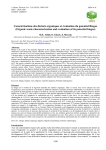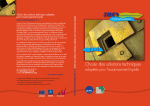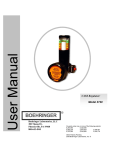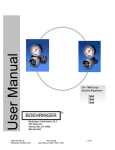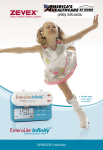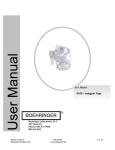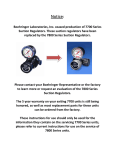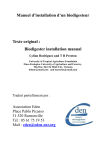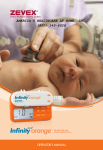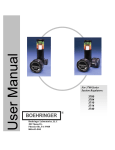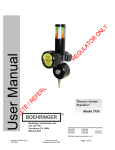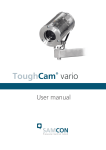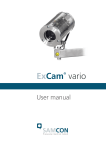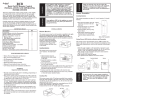Download Cleaning Recommendations - Boehringer Laboratories, Inc.
Transcript
Boehringer Suction Regulator Recommendations for Cleaning Disinfection and Processing Boehringer Laboratories, Inc. 300 Thoms Drive Phoenixville, PA 19460 800-642-4945 ©2010 Boehringer Laboratories, LLC. 7700.192 Rev B Boehringer Suction Regulator Processing Guide Page 1 of 9 Boehringer Quick Reference Guide Event Recommended Processing Method ROUTINE CLEANING: On a routine basis, the external surfaces of the suction regulator must be treated in a similar fashion to other patient contact surfaces in your facility. STAFF RISK REDUCTION: Prior to performing service or after fluid intrusion, the suction regulator must be handled in accordance with your hospital’s infection control policies and should be high-level disinfected or sterilized. PER PATIENT: To minimize the risk of cross contamination, it is recommended that intermitting suction regulators be high-level disinfected or sterilized in-between patient uses. ALTERNATIVE PER PATIENT HANDLING: High-level disinfection and sterilization of suction regulators between patients may be avoided by implementing a 48 hour or sooner canister change protocol when using Boehringer suction regulators. In Vitro testing has not demonstrated this effect with any other marketed suction regulator. 7700.192 Rev B Boehringer Suction Regulator Processing Guide Page 2 of 9 Terminology VACUUM WARNING CAUTION IMPORTANT CONTAMINATED DECONTAMINATION DISINFECTION STERILIZATION STERILIZABLE Process(ing) Air or other gases at sub atmospheric pressure typically expressed as mmHg or cm H20 Alerts user to actions or conditions that could result in injury to user or patient Alerts user to actions or conditions that can cause damage to the device or may result in substandard performance of the device or system. Indicates an action that is emphasized to ensure proper operation of equipment State of having been actually or potentially in contact with microorganisms The use of physical or chemical means to remove, inactivate, or destroy blood borne pathogens on a surface or item to the point where they are no longer capable of transmitting infectious particles and the surface or items is rendered safe for handling or disposal. A process used to reduce the number of viable microorganisms on a product to a level previously specified as appropriate for its further handling use. A validated process used to render a device free from all forms of viable microorganisms Term used to describe devices that possess the characteristics required to withstand various sterilization processes Act of subjecting medical devices to the various routes used for disinfection and sterilization Safety Information WARNING! Boehringer suction regulators are intended to be cared for per the instructions in this manual as well as the Instructions for Use that are provided with your specific suction controls. Failure to follow the guidelines herein may result in unsatisfactory levels of disinfection. Suction regulators are used in a clinical setting on a variety of patients. The mechanisms that allow the regulators to function can result in biological contamination of the device though there are no apparent signs of contamination. Always utilize appropriate PPE when handling suction controls that have been in clinical use. Failure to ensure that the regulator is properly working after processing can increase patient risk. Ensure that suction controls work properly before they are returned to service. CAUTION! Hydrophobic filters, gravity shut offs, and gravity safety traps provide a barrier to gross biological contamination but do not prevent microbiological pathogens from entering the suction control. Be mindful that these measures alone do not ensure a pathogen free device will be returned to clinical service. 7700.192 Rev B Boehringer Suction Regulator Processing Guide Page 3 of 9 Purpose This decontamination guide provides instruction for the recommended care and cleaning of Boehringer suction controls. The instructions herein are meant to assist in the development of safe handling and effective reprocessing procedures for Boehringer suction controls. A variety of personnel in the hospital will interact with suction controls including clinical and support personnel. Hospital directors and management in charge of any departments that may be responsible for handling these devices should be informed of these recommendations to ensure the safety of hospital employees and patients while preventing the damage or misuse of these devices. Scope MODELS This document contains recommended instructions for the safe care, handling and decontamination of the entire line of Boehringer suction controls, including all 7700, 3700, 7800 & 3800 series designs. This instruction sheet is an addendum to, and not a replacement for the complete instructions for use for your suction control. Please refer to our website www.boehringerlabs.com DECONTAMINATION The decontamination protocols described herein are intended to be used on regulators that have been grossly contaminated. Devices that show no signs of gross fluid intrusion may not require decontamination and may have sufficiently low bio-burden such that they may only require processing through an autoclave. It is the responsibility of the hospital to determine whether or not gross decontamination is required1, see page 5 for inspection instructions. DISINFECTION Routine disinfection at patient turnover may be prudent as a regular practice. At a minimum, the external surfaces of the suction regulator must be treated in a similar fashion to other patient contact surfaces in your facility. Whether or not internal disinfection is required depends on the risk associated with the contaminated device for the particular clinical application. Prior to performing service or after fluid intrusion, the suction regulator must be handled in accordance with your hospital’s infection control policies and should be high-level disinfected or processed in order to reduce risk to staff. 1 Gross contamination of suction equipment is an extraordinary event. Normal precautions such as the appropriate use of collection canisters, gravity trap bottles, and hydrophobic filters reduce, but do not eliminate the probability of such events. 7700.192 Rev B Boehringer Suction Regulator Processing Guide Page 4 of 9 PROCESSING Processing through an autoclave is recommended between patients to ensure that the maximum numbers of infectious agents are inactivated. The instructions contained herein describe methods by which Boehringer suction controls can be processed. It is the responsibility of the hospital to ensure that any devices subjected to these guidelines have been appropriately processed. Processing through an autoclave may be avoided by implementing a 48 hour or sooner canister change protocol when using Boehringer suction regulators. In vitro testing has not demonstrated this effect with any other marketed suction regulator. Considerations The instructions contained herein describe the procedure for effective processing of certain Boehringer suction regulators. Refer to the detailed instructions in this manual to determine which models are suitable for which type of processing. The end user / individual / department responsible for processing these devices should comply with local laws and ordinances in countries where reprocessing requirements are more stringent than those detailed in this manual. Suction regulators are generally not considered sterile instruments and are not often stored in sterile containers before use. The hospital is responsible to determine in what cases processed suction controls are required over disinfected controls. Healthcare systems are responsible for determining an appropriate protocol for the scheduling of regulator decontamination. Regulators that have been in contract with high risk patients may require immediate decontamination, whereas those that have been in contact with low risk patients may be able to be reused with disinfection only. Instructions Note: Refer to Appendix A for a detailed flow chart indicating the recommended steps for the processing of suction controls. PRECAUTIONS o o o o All hospital personnel are recommended to observe universal precautions when handling contaminated or potentially contaminated medical devices. In exercising universal precautions, healthcare employees are recommended to wear personal protective equipment (PPE) while handling contaminated or potentially contaminated medical equipment. Suction regulator components should be cleaned with soft-bristled, nylon brushes and pipe cleaners. The use of metal brushes and scouring pads should be avoided to prevent damage to surface finishes on the devices. Unfortunately current suction regulator decontamination practices generally allow for the drying of contaminants within the regulators and unintentional gross contamination may go unnoticed until a scheduled service event. In the event that a regulator presents with dried contaminants, ensure that all dried debris are completely removed from all regulator surfaces during the decontamination process. 7700.192 Rev B Boehringer Suction Regulator Processing Guide Page 5 of 9 POINT OF USE PREPARATIONS o Wipe all exterior surfaces of the regulator with a surface disinfectant per manufacturer’s instructions. Appropriate disinfectants are: o 3M Quat® o Cavacide® o 1:10 bleach solution (wipe, but do not soak in bleach) o Refer to the instrument’s user manual for instruction on internal disinfection via back-flushing the unit. INITIAL ASSESSMENT o To determine whether or not the unit has been grossly contaminated, loosen the set screw (2 turns max) on the control knob with a 1/16th Allen key. o Remove the adjustment knob (refer to the user manual for more detailed instructions). o Visually inspect the piston/stem assembly for signs of gross contamination. o If the unit shows no visible contamination, the adjustment knob should be reattached so that the unit can be processed. o If visible contaminants are present, the unit requires complete disassembly and gross decontamination (refer to the device’s user manual for detailed instruction on this process). 7700.192 Rev B Boehringer Suction Regulator Processing Guide Page 6 of 9 DECONTAMINATION Once the unit has been disassembled, all components should be allowed to soak in an enzymatic cleaning solution such as LiquinoxTM for 20 minutes (note: do not submerge dial gauges). Some of the Boehringer components are factory mated and should be kept with the original device. Please refer to your products instructions for use for complete details. o All components with visible contamination should then be scrubbed with a soft-bristled nylon brush or some other appropriate cleaning device until all visible soil has been removed. Manual cleaning is preferred over automated wash cycles. Automated washers may be used provided they do not exceed 250°F and highly alkaline cleaners are not used. o The components should then be removed from the solution and rinsed with tap water for 3 minutes. o Components may additionally be placed in an ultrasonic cleaner, completely submerged (note: do not submerge dial gauges), for 10 minutes. o The parts should then be rinsed with purified water for 3 minutes ensuring that no contamination or cleaning solutions remain. o In the event that signs of contamination remain, repeat the steps above. *Dial gauges can be externally decontaminated with the use of mild disinfectants (refer to the user manual for instructions). PROCESSING o o o Boehringer suction controls should be processed in a pre-vacuum autoclave at 250ºF for 30 minutes. o Suction regulators should be set to the “continuous” or “REG” positions during this process. o Suction regulators with dial gauges must be oriented such that the gauge is vertical to prevent pooling of liquids in the gauge. o Ensure the patient and supply ports of the device are open to allow the steam to access the interior of the device. Units may be allowed to air dry or be attached to a vacuum source for one minute to ensure internal drying. Heated drying cycles must not exceed 250°F. Ensure the device has thoroughly cooled to the touch before returning to clinical service. It is the responsibility of the hospital to ensure that all suction controls returned to Boehringer have been appropriately disinfected or decontaminated. 7700.192 Rev B Boehringer Suction Regulator Processing Guide Page 7 of 9 APPENDIX A: Understanding Boehringer’s Position on Suction Regulator Processing In the mid 1960s Dr. Earl Spaulding, Chair of Microbiology and Immunology from 1949 to 1972 at Temple University’s School of Medicine, created a system to identify a patient’s risk for infection from medical instruments. This system was simple to understand and is widely accepted in the U.S. and repeatedly cited by the CDC. Infectious disease doctors and Sterile Processing Departments understand the implications of Spaulding. This system is a guide to assist hospital personnel in identifying the proper cleaning, disinfection and sterilization requirements for all of their equipment. Spaulding does not call out which equipment falls into which category, but rather based on the risk of the instrument and where it is used will dictate its classification in this scheme. The Spaulding Classification states the following Classification Definition Equipment Examples Level of Processing Required Effectiveness of Cleaning Sample Processing Products Noncritical Equipment Equipment that touches only intact skin and not mucous membranes, or does not directly touch the client/patient/resident Environmental Surfaces, Stethoscopes, BP Cuffs, Baby scales Semi-critical Equipment Equipment that comes in contact with non-intact skin or mucous membranes but do not penetrate them Laryngoscopes, Anesthesia Equipment, Fingernail Care, Suction Regulators, Cleaning followed by Cleaning followed by low level disinfection. high level disinfection In some cases, cleaning (HDL) at a minimum. alone is acceptable Sterilization is preferred Low Level Disinfection High Level Disinfection kills most vegetative destroys vegetative bacteria, some fungi and bacteria, mycobacterium, some viruses. DOES fungi and most viruses. NOT KILL DOES NOT KILL MYCOBACTERIA OR SPORES. SPORES. Soak for 10 minutes in Soak for 20 minutes in 3% Hydrogen Peroxide, 2% glutaraldehyde, 6% 60-95% Alcohol or Hydrogen peroxide or Quaternary disinfectant Cidex OPA Critical Equipment Equipment that enters sterile tissues including the vascular system Surgical Instruments, Endoscopes, Foot Care Equipment, Eye Equipment Cleaning followed by sterilization Sterilization destroys all forms of microbial life including bacteria, viruses, spores and fungi Steam autoclaving is the most commonly used method; however, sterilization with hydrogen peroxide (Sterrad), ETO or Peracetic acid (STERIS) is also accepted. Traditionally, people would have placed suction regulators into a ‘Non-Critical ‘category. In this category the only required cleaning and processing would be to wipe down the outside of the unit. The 7700.192 Rev B Boehringer Suction Regulator Processing Guide Page 8 of 9 internal lumens of the regulator would not be touched and would remain contaminated between patients. The fact that intermitting regulators connect directly with the mucous membranes of the stomach, and that there is a demonstrated risk from the contaminants in the regulator, has made people consider these instruments for inclusion into the Semi-Criticial Classification. As a result of being included in this classification, suction regulators require at a minimum, a high level disinfection, but prefer sterilization. Additional References: Kaye K, Marchaim D, Smialowicz C and Bentley L. “Suction Regulators: A Potential Vector for Hospital-Acquired Pathogens.” Infection Control and Hospital Epidemiology. 2010; 31(7):772774. Boehringer Laboratories, LLC 300 Thoms Drive Phoenixville, PA 19460 For Customer Service Or Technical Support 800-642-4945 www.boehringerlabs.com A free trial evaluation of any of our suction regulators can be arranged by calling (800) 642-4945 or 610-278-0900. 7700.192 Rev B Boehringer Suction Regulator Processing Guide Page 9 of 9









